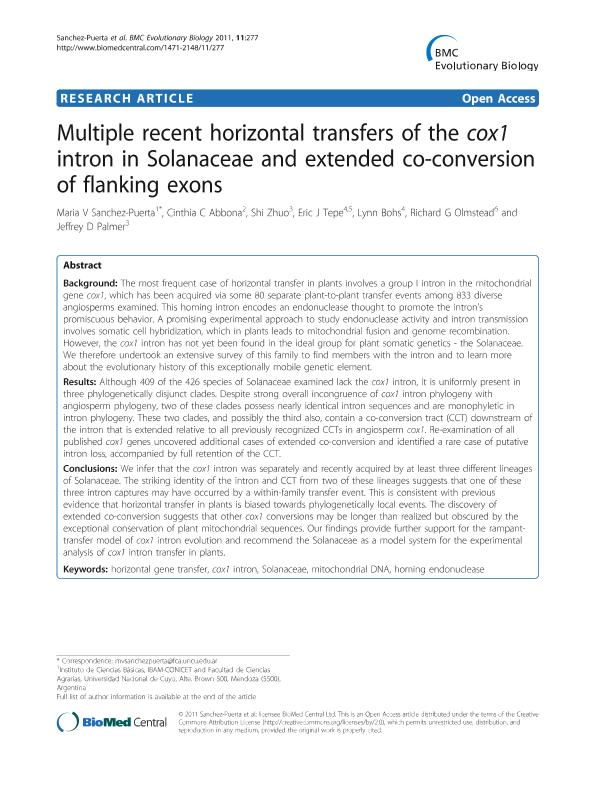Mostrar el registro sencillo del ítem
dc.contributor.author
Sánchez Puerta, María Virginia

dc.contributor.author
Abbona, Cinthia Carolina

dc.contributor.author
Zhuo, Shi
dc.contributor.author
Tepe, Eric J.
dc.contributor.author
Bohs, Lynn
dc.contributor.author
Olmstead, Richard G.
dc.contributor.author
Palmer, Jeffrey D.
dc.date.available
2020-05-12T17:30:19Z
dc.date.issued
2011-09
dc.identifier.citation
Sánchez Puerta, María Virginia; Abbona, Cinthia Carolina; Zhuo, Shi; Tepe, Eric J.; Bohs, Lynn; et al.; Multiple recent horizontal transfers of the cox1 intron in Solanaceae and extended co-conversion of flanking exons; BioMed Central; BMC Evolutionary Biology; 11; 277; 9-2011; 277-292
dc.identifier.issn
1471-2148
dc.identifier.uri
http://hdl.handle.net/11336/104895
dc.description.abstract
Background: The most frequent case of horizontal transfer in plants involves a group I intron in the mitochondrial gene cox1, which has been acquired via some 80 separate plant-to-plant transfer events among 833 diverse angiosperms examined. This homing intron encodes an endonuclease thought to promote the intron´s promiscuous behavior. A promising experimental approach to study endonuclease activity and intron transmission involves somatic cell hybridization, which in plants leads to mitochondrial fusion and genome recombination. However, the cox1 intron has not yet been found in the ideal group for plant somatic genetics - the Solanaceae. We therefore undertook an extensive survey of this family to find members with the intron and to learn more about the evolutionary history of this exceptionally mobile genetic element. Results: Although 409 of the 426 species of Solanaceae examined lack the cox1 intron, it is uniformly present in three phylogenetically disjunct clades. Despite strong overall incongruence of cox1 intron phylogeny with angiosperm phylogeny, two of these clades possess nearly identical intron sequences and are monophyletic in intron phylogeny. These two clades, and possibly the third also, contain a co-conversion tract (CCT) downstream of the intron that is extended relative to all previously recognized CCTs in angiosperm cox1. Re-examination of all published cox1 genes uncovered additional cases of extended co-conversion and identified a rare case of putative intron loss, accompanied by full retention of the CCT. Conclusions: We infer that the cox1 intron was separately and recently acquired by at least three different lineages of Solanaceae. The striking identity of the intron and CCT from two of these lineages suggests that one of these three intron captures may have occurred by a within-family transfer event. This is consistent with previous evidence that horizontal transfer in plants is biased towards phylogenetically local events. The discovery of extended co-conversion suggests that other cox1 conversions may be longer than realized but obscured by the exceptional conservation of plant mitochondrial sequences. Our findings provide further support for the rampant-transfer model of cox1 intron evolution and recommend the Solanaceae as a model system for the experimental analysis of cox1 intron transfer in plants.
dc.format
application/pdf
dc.language.iso
eng
dc.publisher
BioMed Central

dc.rights
info:eu-repo/semantics/openAccess
dc.rights.uri
https://creativecommons.org/licenses/by-nc-sa/2.5/ar/
dc.subject
MITOCHONDRIAL DNA
dc.subject
COX1 INTRON
dc.subject
MITOCHONDRIAL DNA
dc.subject
HOMING ENDONUCLEASE
dc.subject.classification
Biología

dc.subject.classification
Ciencias Biológicas

dc.subject.classification
CIENCIAS NATURALES Y EXACTAS

dc.title
Multiple recent horizontal transfers of the cox1 intron in Solanaceae and extended co-conversion of flanking exons
dc.type
info:eu-repo/semantics/article
dc.type
info:ar-repo/semantics/artículo
dc.type
info:eu-repo/semantics/publishedVersion
dc.date.updated
2020-04-28T14:35:35Z
dc.journal.volume
11
dc.journal.number
277
dc.journal.pagination
277-292
dc.journal.pais
Reino Unido

dc.journal.ciudad
Londres
dc.description.fil
Fil: Sánchez Puerta, María Virginia. Consejo Nacional de Investigaciones Científicas y Técnicas. Centro Científico Tecnológico Conicet - Mendoza. Instituto de Biología Agrícola de Mendoza. Universidad Nacional de Cuyo. Facultad de Ciencias Agrarias. Instituto de Biología Agrícola de Mendoza; Argentina
dc.description.fil
Fil: Abbona, Cinthia Carolina. Consejo Nacional de Investigaciones Científicas y Técnicas. Centro Científico Tecnológico Conicet - Mendoza. Instituto de Biología Agrícola de Mendoza. Universidad Nacional de Cuyo. Facultad de Ciencias Agrarias. Instituto de Biología Agrícola de Mendoza; Argentina
dc.description.fil
Fil: Zhuo, Shi. Indiana University; Estados Unidos
dc.description.fil
Fil: Tepe, Eric J.. University of Cincinnati; Estados Unidos. University of Utah; Estados Unidos
dc.description.fil
Fil: Bohs, Lynn. University of Utah; Estados Unidos
dc.description.fil
Fil: Olmstead, Richard G.. University of Washington; Estados Unidos
dc.description.fil
Fil: Palmer, Jeffrey D.. Indiana University; Estados Unidos
dc.journal.title
BMC Evolutionary Biology

dc.relation.alternativeid
info:eu-repo/semantics/altIdentifier/url/http://www.biomedcentral.com/1471-2148/11/277
dc.relation.alternativeid
info:eu-repo/semantics/altIdentifier/doi/http://dx.doi.org/10.1186/1471-2148-11-277
Archivos asociados
